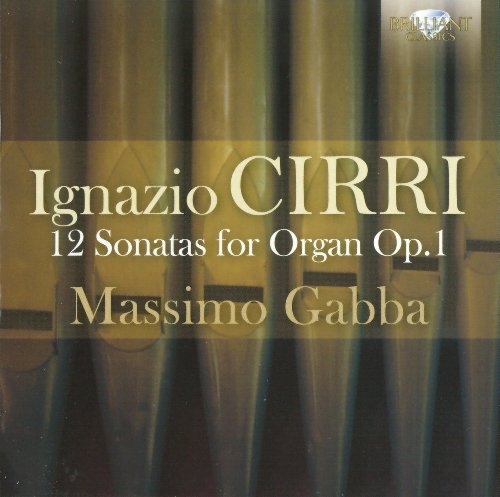Massimo Gabba - Ignazio Cirri: 12 Sonatas For Organ, Op. 1 (2015)

Artist: Massimo Gabba
Title: Ignazio Cirri: 12 Sonatas For Organ, Op. 1
Year Of Release: 2015
Label: Brilliant Classics
Genre: Classical
Quality: FLAC (image + .cue, log, scans)
Total Time: 69:40 min
Total Size: 325 MB
WebSite: Album Preview
Tracklist:Title: Ignazio Cirri: 12 Sonatas For Organ, Op. 1
Year Of Release: 2015
Label: Brilliant Classics
Genre: Classical
Quality: FLAC (image + .cue, log, scans)
Total Time: 69:40 min
Total Size: 325 MB
WebSite: Album Preview
Sonata No.1 in C major
Sonata No.2 in F major
Sonata No.3 in G minor
Sonata No.4 in G major
Sonata No.5 in C minor
Sonata No.6 in A major
Sonata No.7 in B flat major
Sonata No.8 in D major
Sonata No.9 in F minor
Sonata No.10 in A major
Sonata No.11 in G minor
Sonata No.12 in D major
This is the lesser-known Cirri, Ignazio of that ilk, elder brother of the Giovanni Battista who after taking holy orders pursued a diverse career as a cellist and composer, and who in 1764, perhaps aided by Ignazios contacts, settled in London, where he was employed as a chamber musician to the Duke of York and director of music for the Duke of Gloucester, coming to compose a lovely, cheerfully undemanding set of trio sonatas, printed as his Op.9, for the Duke of Cumberland, and some more adventurous cello sonatas which display the instrument in an increasingly independent role. We know a bit less about Ignazio, though both brothers were certainly in town when the eight-year-old prodigy Mozart arrived in the summer of 1764 with his family caravan of Leopold and Nannerl (gave concerts, caught a cold and composed his First Symphony). The year before his brothers arrival, Ignazio had had printed this set of organ sonatas, called his Opus One. Seven years later was published an Op.2 collection for violin and keyboard. The 12 sonatas of Op.1 follow a pre-Classical structure, in two distinct movements, composed in a form somewhere between the Scarlatti sonata-form (a single movement in two parts) and Sonata Form as we have come to understand the term. It is possible that Ignazio was inspired by the keyboard sonatas by Pietro Domenico Paradisi, also published in London in 1754, sharing the brilliant and elegant style typical of 17th century Italian music. Massimo Gabbas discography for Brilliant has included Romantic transcriptions of Handel and the complete organ music of August Gottfried Ritter (1811-1885), both of which attest to a stylish response on suitable instruments, whatever the repertoire.





![The Mood Mosaic - Soul Seduction (2025) [Hi-Res] The Mood Mosaic - Soul Seduction (2025) [Hi-Res]](https://www.dibpic.com/uploads/posts/2025-12/1766135288_d5rmbmuwqtmya_600.jpg)

![Clifton Chenier - Classic Clifton (1980) [Hi-Res] Clifton Chenier - Classic Clifton (1980) [Hi-Res]](https://img.israbox.com/img/2025-12/20/7uht6cuaz3rb4d8ybfskyckea.jpg)
